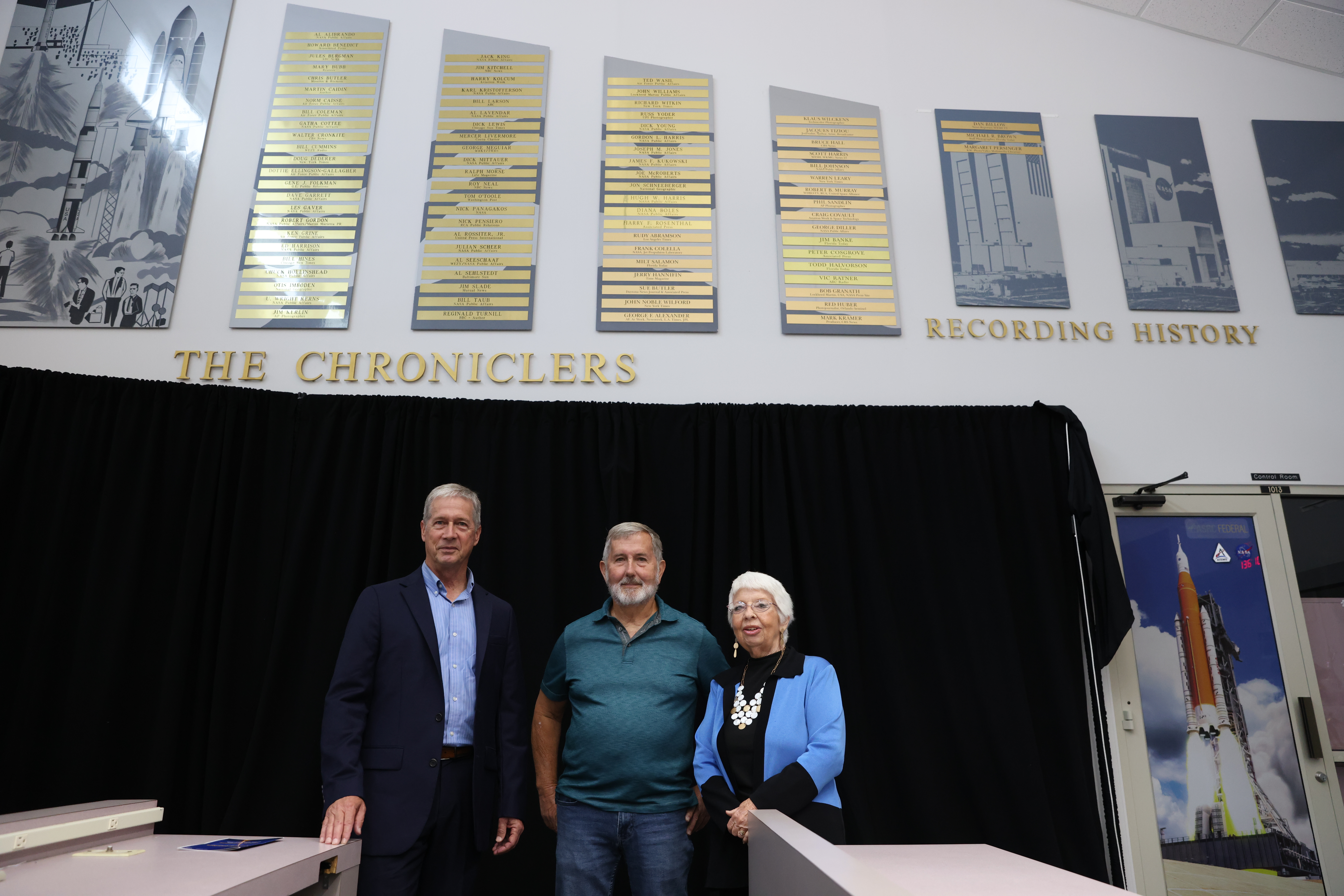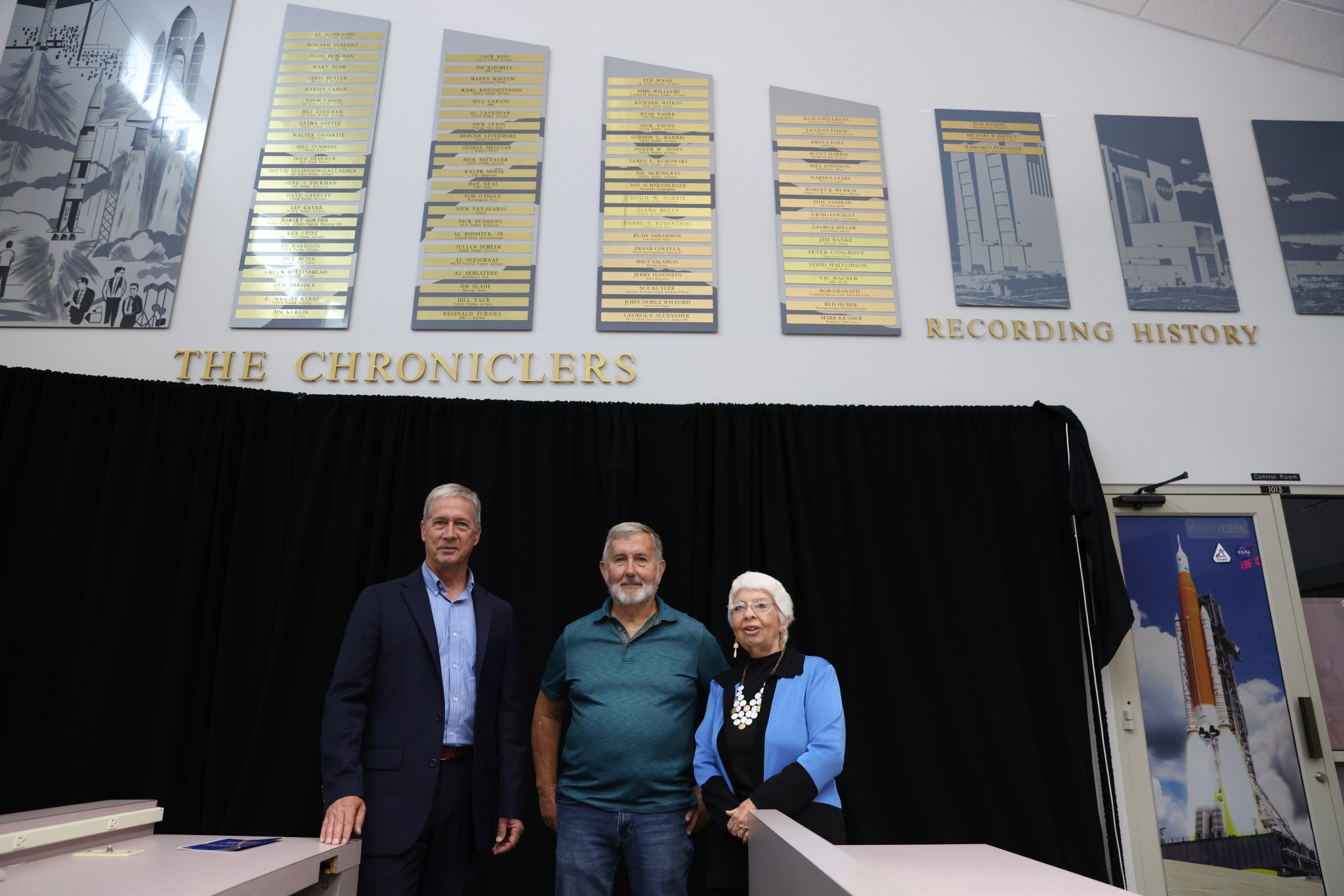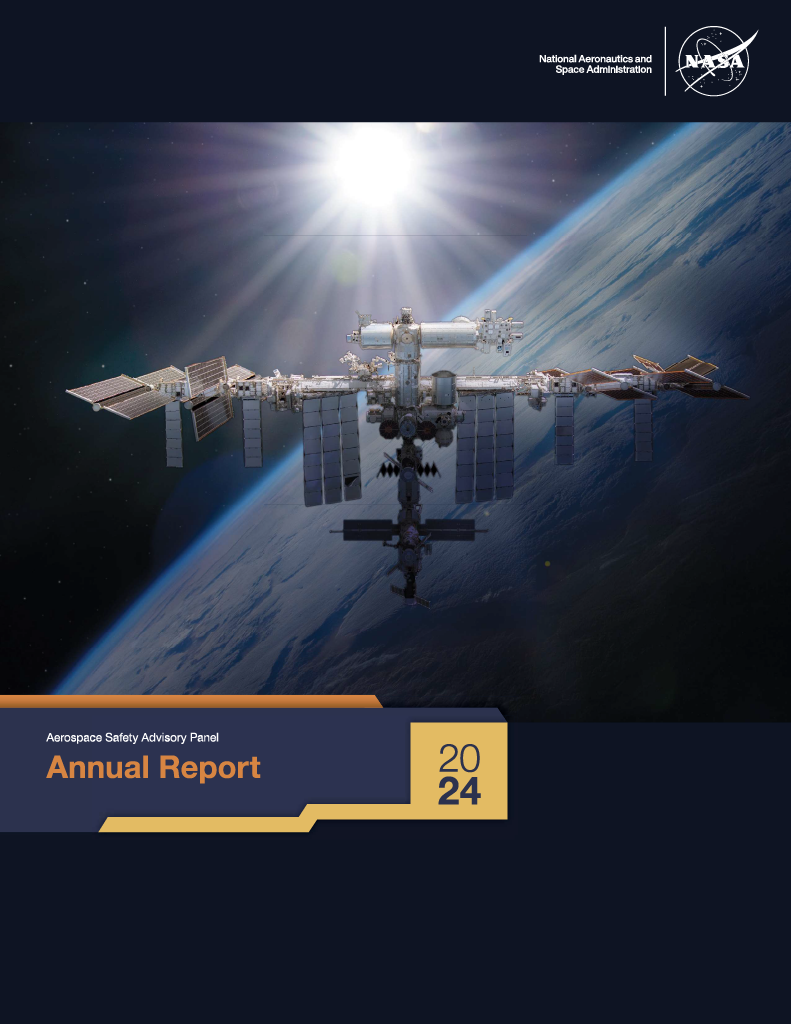NASA Honors Three Chroniclers for Helping Tell America’s Space Story
Through decades of hard work, three storytellers brought out of this world news down to Earth, providing a lens through which young and old could watch space exploration unfold. This week, NASA recognized the contributions of these Chroniclers during a May 15, 2024, ceremony at the agency’s Kennedy Space Center in Florida. NASA Kennedy Space […]

Through decades of hard work, three storytellers brought out of this world news down to Earth, providing a lens through which young and old could watch space exploration unfold. This week, NASA recognized the contributions of these Chroniclers during a May 15, 2024, ceremony at the agency’s Kennedy Space Center in Florida.
NASA Kennedy Space Center’s Associate Director of Management Burt Summerfield was at the spaceport’s Press Site for the unveiling of three brass plates bearing the names of the 2024 honorees – Dan Billow, Michael R. Brown, and Margaret (Maggie) Persinger.

“The Chroniclers ceremony is one of Press Site’s greatest traditions,” Summerfield said. “We get a chance to extend our deepest thank you to members of the media – and our NASA and industry communicators – who go above and beyond to tell our story to the world,”
The inductees join the list of 82 other Chroniclers awardees whose names hang proudly on the wall in the “bullpen” at Kennedy’s Press Site, where journalists, photographers and broadcasters have gathered to cover the space industry since 1962.
The honorees were nominated by other members of the news media and selected by a panel of NASA officials and current space reporters.
Dan Billow was born in 1960 in Orange County, California. He earned his bachelor’s degree in 1982 in radio and television from California State University in Fullerton and completed a certificate in meteorology from Mississippi State University in 2008.
Dan began his career in 1982 as a news reporter at KRCR-TV in Redding, California. From 1985 to 1987, he worked as a news reporter with KLAS-TV in Las Vegas, Nevada. In 1987, Dan took a job with WESH-TV in Orlando, Florida, as a news reporter and meteorologist. While there, he covered all space shuttle missions from 1988-2011. He also covered NASA’s Earth and other planetary missions, including Mars landings, spacecraft flights to Mercury, Venus, Jupiter, Saturn, Uranus, Neptune, Pluto, the Sun, and Earth’s moon. Dan experienced weightlessness in a NASA KC-135 aircraft in 1998, and he even experienced simulated space shuttle landings in a Shuttle Training Aircraft commanded by astronaut Chris Ferguson in 2011.
Dan earned the Society of Professional Journalists Silver Medallion in 2003 and the duPont-Columbia Award in 2004 for coverage of the Space Shuttle Columbia tragedy, as well as three regional Emmy awards.
Dan retired in 2021, settling in the Blue Ridge Mountains of Georgia with his wife of 41 years, Rebecca. They have three adult children: Alex, Jordan, and Marie.
“Spaceflight is romance – there’s an element of grandeur to it – and that’s the way I covered it,” Billow said. “Spaceflight is beauty, and I will continue to watch the next generation of reporters covering it.”
Michael R. Brown served in the United States Navy from 1968 to 1972. Following his Navy service, Michael studied photography at the Art Institute of Fort Lauderdale from 1974 to 1976 and launched his career as a photojournalist beginning with the Thomasville Times in Georgia in 1977.
In 1978, Michael accepted a job with Florida Today as a photojournalist. He had many notable accomplishments during his 34-year career with Florida Today, including covering all 135 Space Shuttle launches as well as the launches of hundreds of expendable rockets. Notably, he was recognized as a finalist for the 1987 Pulitzer Prize for his photo coverage of the Space Shuttle Challenger tragedy. Michael now lives and works in Florida as a freelance photographer.
“We had a lot of fun setting up remote cameras during shuttle days to get just the right shots,” Brown said. “If we had an idea for a photo, the people here bent over backwards to make sure we could get what we needed. But working with the people here was what I really enjoyed most.”
Margaret (Maggie) Persinger began her career at NASA’s Kennedy Space Center in Florida as an archivist assistant in 1975. As a result of her in-depth research of the space program at Kennedy, she was hired by Technicolor to work as a film file at the Motion Picture Lab at Patrick Air Force Base in Florida from 1978 to 1986. Maggie then moved to the Photo Lab at NASA’s Kennedy Space Center in Florida where she worked until 1992, ending her time as lead of the Film File Library.
In 1992, Margaret transferred to Kennedy’s Press Site, providing still imagery to newspapers, wires, and magazines via black and white as well as color photos, slides, and transparencies. With the rise of the digital era, imagery transitioned to include photo CDs and eventually to digital images on the internet. These shifts in technology required learning brand new techniques, procedures, computers, and programs. With her knowledge and experience, Maggie became the Photo Editor at Kennedy.
In 1995, Maggie’s responsibilities grew to include video, motion picture film, and audio tape releases to the media. Originally this entailed research into the subject matter on VHS, beta tapes, and audio tapes used by TV, motion picture film productions, and radio. It wasn’t long before technology growth changed the nature of her job again with the introduction of high-definition capability and tapes, which added to the already extensive library. Hard copy tapes eventually gave way to digital formats, requiring Maggie to edit video clips that could be rapidly released to the media via computer, thumb drives, or large capacity decks enabling a vast amount of footage. Without a requirement to mail tapes, videos shot at Kennedy to be edited and viewed quickly around the world.
Maggie’s career saw many advances in film and technology, allowing her the rare opportunity to work with many types of media – newspapers, wires, magazines, TV, documentaries, motion picture film productions, and social media.
“I was so proud of what NASA is doing and that I could help get word out to the public,” Persinger said. “Back when we worked with print photos and tape, I remember meeting reporters at all hours and at locations like the bowling alley to be sure they had what they needed for their stories.”
The Chroniclers ceremony is typically held in early May to honor the first U.S. human spaceflight, Mercury-Redstone 3, or Freedom 7, on May 5, 1961. The 15-minute, 28-second flight sent astronaut Alan Shepard into orbit around Earth, ending with a successful splashdown in the Atlantic Ocean.
For more listings of all The Chroniclers, visit: The Chroniclers – NASA
What's Your Reaction?



















.jpg?#)































